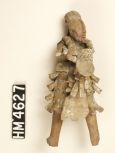Maya Society
 Maya society was broken into a class structure with four main levels: the nobility (Maya almehenob), the priesthood (Maya ahkinob), the common people (Maya ah chembal uinieol), and the slaves (Maya ppencatob). The most powerful of the ruling elite was known as the halach uinic (HM 1172), or “true man.” As a hereditary position the office of halach uinic was typically passed from father to eldest son; however, when no suitable heir was available, a council of lords would elect a successor from the noble families. The halach uinic held ultimate political authority over the city-state and saw to civil affairs as well as relations with neighboring cities. So revered was the halach uinic that a cloth was held in front of his face to prevent anyone from speaking to him directly. From the wealthy Maya aristocracy that made up the nobility (HM 4627), the halach uinic selected provincial managers known as batabs. These batabs would assist the halach uinic in controlling local governments and would oversee the village’s required payment of tributes (taxes) to the hierarchy.
Maya society was broken into a class structure with four main levels: the nobility (Maya almehenob), the priesthood (Maya ahkinob), the common people (Maya ah chembal uinieol), and the slaves (Maya ppencatob). The most powerful of the ruling elite was known as the halach uinic (HM 1172), or “true man.” As a hereditary position the office of halach uinic was typically passed from father to eldest son; however, when no suitable heir was available, a council of lords would elect a successor from the noble families. The halach uinic held ultimate political authority over the city-state and saw to civil affairs as well as relations with neighboring cities. So revered was the halach uinic that a cloth was held in front of his face to prevent anyone from speaking to him directly. From the wealthy Maya aristocracy that made up the nobility (HM 4627), the halach uinic selected provincial managers known as batabs. These batabs would assist the halach uinic in controlling local governments and would oversee the village’s required payment of tributes (taxes) to the hierarchy.
Maya priests also held a very high position in society. In addition to their religious duties, priests were able administrators, scholars, astronomers, and mathematicians. The priesthood carried equal if not more influence among the Mayas as the nobility. Feared and respected for their knowledge, priests were able to take advantage of the superstitions of the masses. Among the duties of priesthood was human sacrifice, a rite performed by a priest called the nacom. Elected for life, the nacom would cut out the heart of sacrificial victims during ceremonies. Other religious practices included the study of divination, interpreting spiritual omens, and predicting future events.
At the bottom of society sat the commoners and slaves. Subject to the rule of the nobles and priests, commoners spent their days as farmers, architects, stonecutters, and carpenters, laboring to support not only themselves but also those above them. Maya architectural splendor can be credited to the commoners. The prevalent use of slaves emerged during the Post-classic era of the Maya. Slaves included prisoners of war, orphans, the children of those already enslaved, and those caught stealing. As law and custom allowed for the possible redemption or paid release of a slave, the length of one’s servitude was not necessarily for life. In general however, slaves were at the mercy of their owners, and were considered too lowly to be given a place in society’s class rank.
